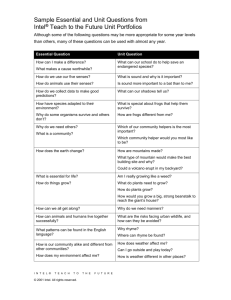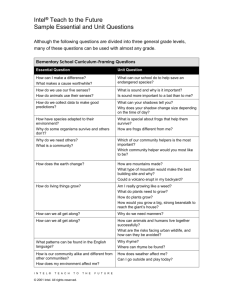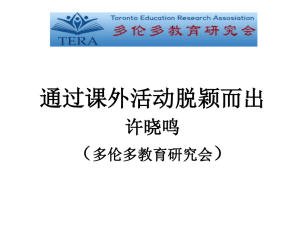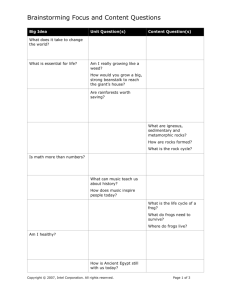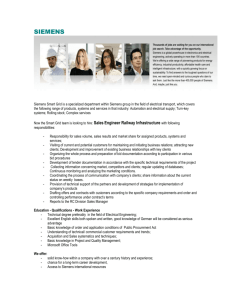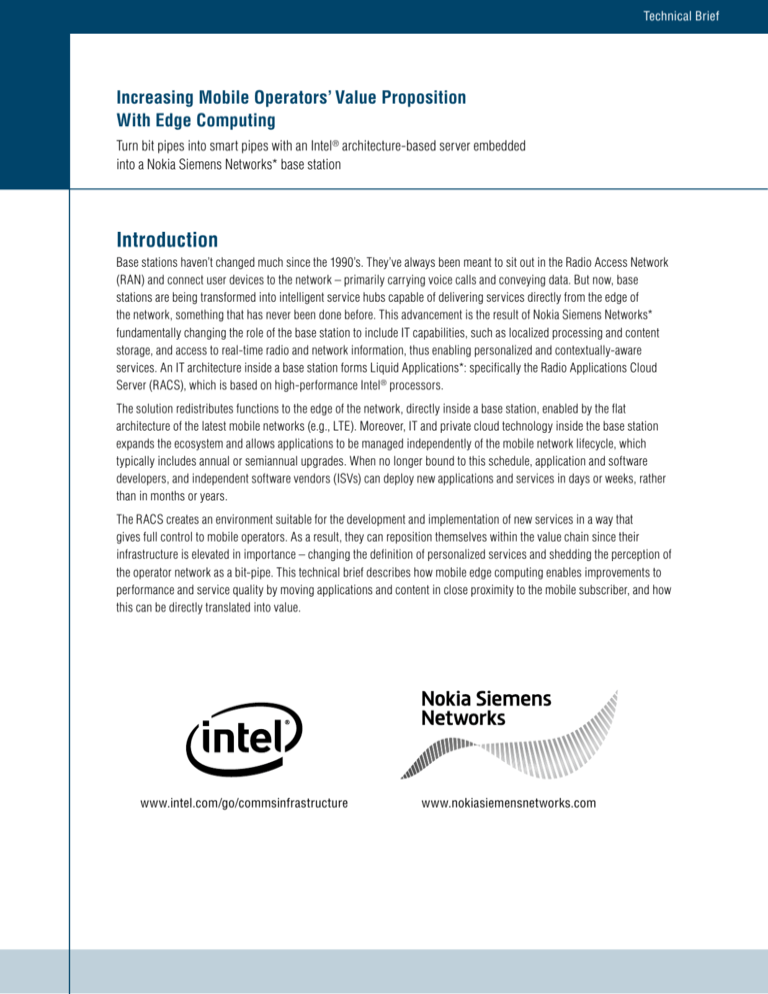
Technical Brief
Increasing Mobile Operators’ Value Proposition
With Edge Computing
Turn bit pipes into smart pipes with an Intel® architecture-based server embedded
into a Nokia Siemens Networks* base station
Introduction
Base stations haven’t changed much since the 1990’s. They’ve always been meant to sit out in the Radio Access Network
(RAN) and connect user devices to the network – primarily carrying voice calls and conveying data. But now, base
stations are being transformed into intelligent service hubs capable of delivering services directly from the edge of
the network, something that has never been done before. This advancement is the result of Nokia Siemens Networks*
fundamentally changing the role of the base station to include IT capabilities, such as localized processing and content
storage, and access to real-time radio and network information, thus enabling personalized and contextually-aware
services. An IT architecture inside a base station forms Liquid Applications*: specifically the Radio Applications Cloud
Server (RACS), which is based on high-performance Intel® processors.
The solution redistributes functions to the edge of the network, directly inside a base station, enabled by the flat
architecture of the latest mobile networks (e.g., LTE). Moreover, IT and private cloud technology inside the base station
expands the ecosystem and allows applications to be managed independently of the mobile network lifecycle, which
typically includes annual or semiannual upgrades. When no longer bound to this schedule, application and software
developers, and independent software vendors (ISVs) can deploy new applications and services in days or weeks, rather
than in months or years.
The RACS creates an environment suitable for the development and implementation of new services in a way that
gives full control to mobile operators. As a result, they can reposition themselves within the value chain since their
infrastructure is elevated in importance – changing the definition of personalized services and shedding the perception of
the operator network as a bit-pipe. This technical brief describes how mobile edge computing enables improvements to
performance and service quality by moving applications and content in close proximity to the mobile subscriber, and how
this can be directly translated into value.
www.intel.com/go/commsinfrastructure
www.nokiasiemensnetworks.com
From Bit Pipe to Smart Pipe
Base Station
(Tower)
Mobile operators are always striving to enhance their customers’
experience, primarily to reduce churn but also to attract new ones.
Customer perception is often shaped by services offered from OverThe-Top (OTT) providers, for example, Skype* and Netflix*, who typically
profit from the rent-free use of mobile operators’ infrastructure. This
one-sided dynamic is driving mobile operators to develop new strategies
intended to change the way their infrastructure is used: from being a bit
pipe providing basic connectivity to becoming an intelligent network that
provides unique, revenue-generating services. Mobile operators need to
find ways to collaborate with other eco-system partners to make money
from the evolving Internet-based interactions in Business-to-Business
(B2B) and Business-to-Consumer (B2C).1 The Nokia Siemens Networks’
RACS provides a means to do just that.
Edge Computing and Storage
> Independent Software
Vendors
> Cloud Infrastructure
Radio Data Access
Standard IT Environment
> Application Service
Providers
Application Interoperability
Context
Proximity
Activity
Figure 1. A base station becomes a value creation engine.
Mobile edge computing provides mobile operators opportunities to
positively impact their customers’ experience through fresh and exciting
personalized service offerings and increased performance. With this
recent development, base stations will be able to tailor the content
they send based on subscriber context that fundamentally changes the
definition of personalized services.
The Move to Mobile Edge Computing
The explosive growth of video is expected to represent 70 percent of
the traffic volume by 2016,2 continuing to be the biggest contributor of
network load within a mobile infrastructure. Furthermore, unpredictable
traffic spikes will increase as a growing number of subscribers watch
viral videos and live television programming at the same time, with
the consumption of this content increasing over mobile devices. Each
subscriber will download the same content, often in the same location,
needlessly wasting network resources.
Value Creation Engine
The new base station platform from Nokia Siemens Networks extends
applications and services that would normally reside within the Internet, or
the centralized core and data centers of mobile operators, to the very edge
of the network and in close proximity of the mobile subscriber. A mobile
operator’s dense network of base stations is transformed by the RACS into
numerous value creation engines. They enable innovative, low-latency
services, such as mobile gaming and augmented reality, and accelerate
media-rich applications that deliver an enhanced quality of experience
for the mobile subscriber. The RACS can process large amounts of data
in real time that would be prohibitively complex and costly to deliver on
a traditional centralized cloud. Figure 1 lists some of the key features that
enable a base station to become a value creation engine:
One solution is to locally cache popular content so it doesn’t have to
be repeatedly pulled from the Internet and across the mobile network.
Today, local caches are typically located outside of a mobile operator’s
RAN, within the core network or just outside. With the RACS, frequently
requested or popular content can be stored inside the base station and
sent directly to mobile devices. This edge computing approach provides
several benefits:
Low cost – Facilitate applications, processing and storage from
the network edge in order to free up valuable core network resources
that alleviate network load and reduce an operator’s Total Cost of
Ownership (TCO).
• Radical user experience improvement – Video downloads from
base stations are up to five times faster3 than from source servers,
typically located deeper in the network.
• Cost savings – The RAN’s backhaul efficiency is increased through
the intelligent processing and caching of data inside the base station.
Manageability – Take advantage of a standard IT environment to
agilely develop and deploy applications.
• Exclusive control – Mobile operators control the applications
running on their base stations and the delivery to the mobile device,
enabling service and experience guarantees to subscribers as well as
other content providers.
Interoperability – Export data to/from external applications platforms
that reside elsewhere within the operator network or the Internet.
Relevance – Make the most of network data, which is unexploited to
date, to provide real-time context to applications.
• Localization features – Unlike devices in the core network, base
stations are uniquely situated to provide location-specific content,
such as special offers from surrounding businesses, or information
about nearby tourist and visitor attractions.
2
2
Use-Case Scenarios
Base Station
Mobile edge computing capabilities enable mobile operators to offer a
wide range of new applications and services, some examples of which
are described below:
Web Page
Coupon
Concourse
Hyper-Targeted Mobile Advertising
PDA
Businesses and product manufacturers (e.g., brands) are constantly
looking for new ways to segment and target consumers, with the
widespread use of smartphones creating some novel opportunities. In
conjunction with the RACS, mobile operators can place specific and
relevant content near stores (Figure 2) or point locations in order to
create a virtual physical area that, when accessed by “opted-in” mobile
subscribers, triggers targeted messages to their smart devices (aka
geofencing). Some examples include:
Store
Cell Phone
Coffee Shop
Shopping Mall
Figure 2. A Radio Applications Cloud Server (RACS) can provide a wide range of services
in a shopping mall.
Media Processing
•Location and direction – Information on where consumers are and
their direction of travel.
Data compression and transcoding can reduce file download time and
graphics computing requirements. The RACS can provide real-time
network data to equipment that transcodes video streams in order to
adapt to network conditions (e.g., congestion) or make adjustments that
accommodate the capabilities of individual endpoints, like smart phones
with small screens. These network functions not only help mobile
operators make more efficient use of their resources, but also improve
performance during peak periods, which could be a source of revenue.
•Analytics – Data on how often consumers are in a specific area and
how long they have stayed there.
• Proximity – Data on when a consumer is about to enter the mall so a
targeted advertisement can be displayed on digital signage nearby.
• Personalized loyalty program – Deal or discount coupons are sent
to the smart device of a consumer in the proximity of a specific store.
Hosted Services
• Promotions – Maps and tourist promotions are sent to the smart
device of a consumer walking inside an airport, near a museum or
gallery, etc, or entering a hotel.
Mobile operators have the capability to host third party applications
and services inside the base station for OTTs and ISVs, who require the
benefits of subscriber proximity and localization. By placing their content
at the point where people connect, mobile subscribers receive a superior
experience, which is a high priority for most OTTs and ISVs, and from
which they can create additional value.
• Engagement – Sports clips are sent to consumers’ smart devices in
real time in a specific location (e.g., a sports bar). Such hyper-targeted
mobile advertisements have been shown to double mobile advertising
revenue, as well as generate as much as a $5 (USD) average revenue
per user (ARPU).4
Content Caching
Mobile subscribers will experience a faster response time when
accessing services directly from the RACS and will not be subjected to
other bottlenecks than the radio interface itself. For example, when a user
wants to stream something that is already available at the base station
(e.g., a video), the download will start faster than usual (approximately
30 percent faster response time) and with a lower probability for the
mobile device to freeze due to network latency or buffering, as there are
no other bottlenecks other than the radio interface itself. This means that
all available radio capacity is at the disposal of the user, compared to the
current situation where videos are typically streamed from the Internet,
often through multiple countries and subject to different speeds, even
during the transfer of the same session.
Service Level Agreements
In mobile networks, RAN awareness can complement real-time policy
management used to prioritize subscribers based on applications and/
or Service Level Agreements (SLAs). Real-time radio data concerning
the mobile cell can be used by other mobile operator equipment (e.g.,
the packet gateway, which handles optimization of content) to ensure
subscribers get a good user experience when the cell is congested.
The same real-time data can guarantee a better quality of service
and experience for premium users on congested cells. When mobile
operators are able to offer dynamic SLAs to enterprise customers or
premium service providers, along with new applications and services,
new business opportunities will arise in premium new markets (e.g.,
Machine-to-Machine, smart cities and other vertical applications).
3
Augmented reality
Point your smart device at a monument and a pop-up window provides
historical information; point your smart device at a restaurant and read
about the specials of the day; or point at a cinema and watch movie
trailers for films currently being shown. This is an experience using
augmented reality, where useful computer–generated renditions are
overlayed onto your physical surroundings via your smart device.
Location-specific augmented reality is already available today, but tends to
be a poor experience as the augmented content has to be fetched across
the network and suffers from network degradation (e.g., latency). With the
RACS, the augmented content can be stored locally, in close proximity
to the mobile subscriber, suffering no network degradation when it is
requested. This is visualized in Figure 3, with a tablet displaying a virtual
location that is enhanced with augmented content, such as:
•A restaurant within walking distance has a special offer on hamburgers.
•Friends of the subscriber have ‘tagged’ themselves at an establishment
down the street.
Figure 3. Augment reality overlays are placed over a virtual location shown on a tablet.
•A hotel nearby has rooms available – reserve with this Uniform
Resource Locator (URL).
host third party content locally on the base station with service level
guarantees for priority content, such as video and mobile-based
financial transactions.
A base station with an edge computing capability processes and conveys
this information, for which a mobile operator can generate revenue from
the featured businesses and the provider of the augmented content.
•Positively disrupt the value chain and connected ecosystem
- An innovative software system allows mobile operators, service
providers and other entities to play complementary and profitable
roles within their respective business models as they monetize the
mobile broadband experience. This includes developing applications
running on a highly distributed cloud made possible by a mobile edge
computing platform inside a base station.
Solution Benefits
Mobile edge computing at the base-station level provides an opportunity
for mobile operators to offer differentiated services that provide the
following benefits:
•Enhance the mobile subscriber experience - Content and data
is stored right where people connect to the network, thus providing
a superior mobile broadband experience. Web-based services and
applications can be significantly accelerated when they are deployed
closer to the customer, with real time network data effectively being
used to contextualize applications.
Transforming Mobile Broadband
Liquid Applications from Nokia Siemens Networks is an innovative
network technology designed to help mobile operators provide a truly
unique and personalized mobile broadband experience. This is achieved
by transforming a base station into a local hub for new service creation
and delivery. The base station places applications, services and content in
close proximity to mobile subscribers using the groundbreaking RACS.
•Reduce TCO - The ability to optimize network traffic by caching
content and delivering services directly from the edge of the network
alleviates network load and frees resources. In addition, the time and
effort needed to develop software in a standard IT environment is
decoupled from protracted 3rd Generation Partnership Project (3GPP)
development cycles, permitting the development of new services in a
fraction of the time that is currently required.
The RACS runs the latest cloud technology and service creation
capabilities on standard IT middleware directly inside the base station. It
provides processing and storage capabilities together with the ability to
collect real-time network data, for example radio conditions, subscriber
location, direction of travel and more. This data can be exploited by
applications to offer context-relevant services that create value for
mobile subscribers. The RACS is fully integrated with the Nokia Siemens
Networks Flexi Multiradio Base Station.
•Enable new revenue opportunities - In collaboration with
other ecosystem partners, mobile operators can create fresh content,
applications and services that take advantage of unique attributes of
subscriber context and proximity. In addition, mobile operators can
4
4
SK Telecom* Focuses on Service-Aware RAN
Intel Under The Hood
SK Telecom*, South Korea’s leading wireless
telecommunications operator, is focusing on realizing
Service-Aware RAN as part of its evolution toward an
upgraded network. Unlike traditional base stations that
essentially only played the role of a communication pipe,
Service-Aware RAN is an intelligent base station that
provides customers with a unique mobile experience
through a wide variety of customized services. Based on the
diverse features of intelligent base stations such as localized
processing, storage and access to real-time radio and
network data, the operator expects to develop services and
applications that deliver a contextualized and personalized
experience to customers.
The edge computing capabilities of the Nokia Siemens Networks RACS
is delivered by the Intel® Xeon® processor based on highly-integrated,
low-power multi-core technology, which allows integration into a nonstandard environment. For example, the Liquid Applications hardware
plus the Intel-based processing platform both fit inside the required
small form factor of a mobile base station. The solution employs several
Intel® technologies, including:
“Telecom providers are realizing that optimized transmission
of data alone can no longer guarantee success in the
market,” said Dr. Choi Jin-sung, Executive Vice President
and Head of ICT R&D Division at SK Telecom. “SK Telecom
will work closely with Nokia Siemens Networks to bring
innovative changes to people’s lives by developing and
applying new network technologies.”
•Intel® Data Plane Development Kit (Intel® DPDK) to speed up packet processing.
•Intel® Virtualization Technology (Intel® VT) to increase performance
and security.
•Intel® Trusted Execution Technology (Intel® TXT) to add another layer
of platform security.
•Intel® AES New Instructions (Intel® AES-NI) to accelerate data
encryption and decryption.
In addition, the extensive Intel ecosystem allows many application
providers to integrate their solutions into the Liquid Applications
platform with minor modifications to their software.
Coordinated Development Effort
Intel® architecture-based solutions are widely used by Application Service
Providers (ASP) and Enterprise cloud implementations globally. The
Nokia Siemens Networks solution drew from Intel’s rich experience and
significant industry investments to implement mobile edge computing at
the base-station level with true telecom characteristics. Nokia Siemens
Networks and Intel worked closely to merge key IT advancements and
telecommunication applications in a way that yields a state-of-the-art
mobile edge computing solution. Both parties are actively collaborating to
educate the ecosystem on the benefits of adding computing to the network
edge, in closer proximity to the end users. This message is being very well
received and is gathering significant support from the market.
For more information about the collaboration, see http://
www.nokiasiemensnetworks.com/news-events/press-room/
press-releases/sk-telecom-nokia-siemens-networkscollaborate-on-liquid-applications-mwc13.
The Nokia Siemens Networks RACS demonstrates high-throughput,
low-latency infrastructure for I/O by optimizing performance using the
Intel DPDK. Combined with the virtualization hardware support features
in Intel processors, the RACS has enough performance headroom to
execute new applications simultaneously on the same platform, thus
creating new revenue streams for operators.
Furthermore, this solution is based on a virtualized infrastructure running
on Linux and built on highly-scalable, Intel-based x86 design, which
means engineering development cost can be minimized. This allows
Nokia Siemens Networks to concentrate their resources on enabling an
easy-to-use development and innovation environment for application
providers. In addition, the existing ecosystem of ISVs, appliance vendors
and ASPs is, to a great extent, prepared to deliver an optimized solution
on Intel architecture, opening new possibilities for the entire value chain.
Figure 3 Scaling HyperScan Performance with Multi-core Intel ® Processors
5
Moving Up the Value Chain
With Liquid Applications, mobile operators can transform the mobile
broadband experience by using their dense network of mobile base
stations, offering their customers benefits that no other provider can
match. Liquid Applications, including the Intel-powered Nokia Siemens
Networks Radio Applications Cloud Server (RACS), will enable mobile
operators to create substantial revenue from new business models,
services and applications. For example, mobile operators could host
content from third parties, such as an ASP, locally on the base station
and provide quality of service guarantees, not only for priority traffic
but also for mobile-based financial transactions, like online banking
and shopping. Furthermore, application developers will be able to use
real-time network data to create innovative services, such as connecting
mobile subscribers with local points-of-interest, businesses and events.
For more information about Liquid Applications from Nokia Siemens Networks, visit
http://www.nokiasiemensnetworks.com/portfolio/liquid-net/intelligent-broadband-management/liquid-applications
For more information about Intel® solutions for communications, visit www.intel.com/go/commsinfrastructure
Source: “Telecom Operators Positioning in the APP Economy: The ‘Pipe’ Way or the Highway,” Delta Partners, April 2012, http://www.deltapartnersgroup.com/telecom-operators-positioning-in-the-app-economy-the-pipe-way-or-the-highway.
Source: http://www.nokiasiemensnetworks.com/news-events/insight-newsletter/articles/do-you-know-when-youtube-had-the-highest-number-of-concurrent-live-streams.
Source: Nokia Siemens Networks internal testing.
4
Source: “Harnessing the Small Cell Opportunity” presentation by Teresa McEneny of Cisco* on December 4, 2012 at Small Cell Americas, Dallas USA, http://www.smallcellsamericas.com/files/0925teresa_2.pdf, slide 11.
1
2
3
Copyright © 2013, Intel Corporation. All rights reserved. Intel, the Intel logo and Xeon are trademarks or registered trademarks of Intel Corporation or its subsidiaries in the United States or other countries.
* Other names and brands may be claimed as the property of others. Printed in USA 0413/MS/SD/PDF Please Recycle 6
Order No. 328909-002US

